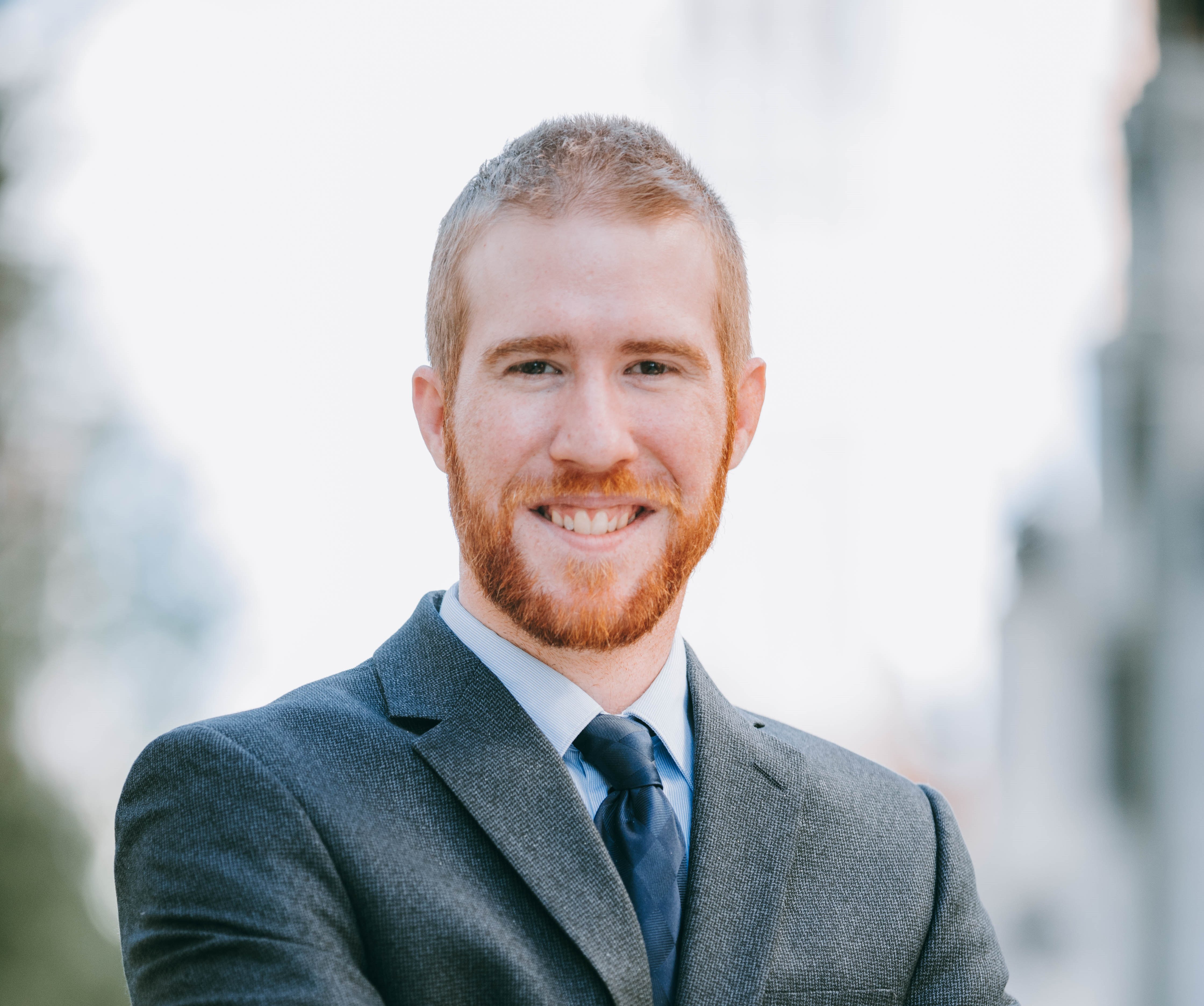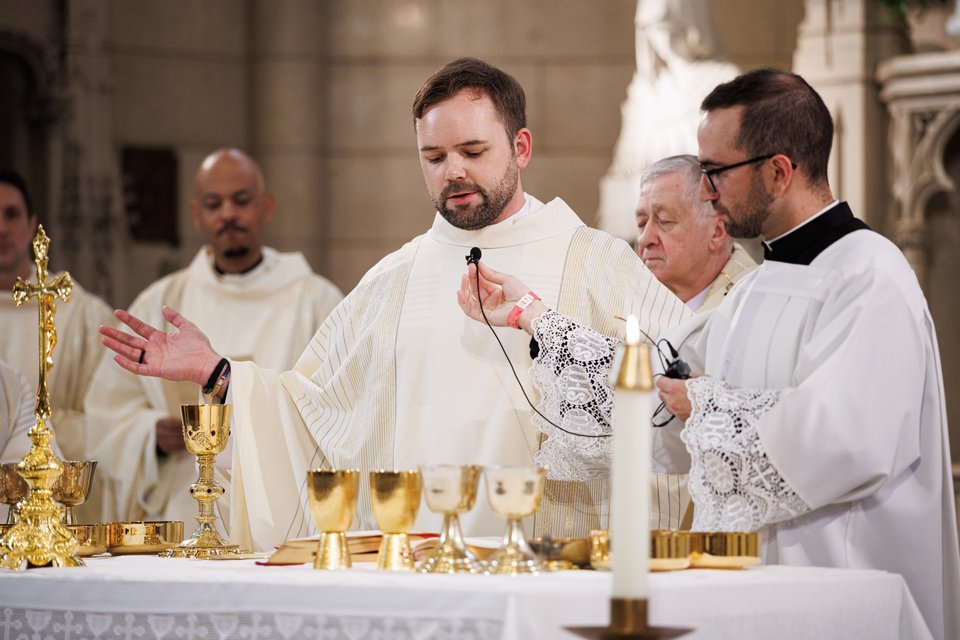 A new 12-foot tympanum depicting St. Anne, the Blessed Virgin Mary and the Christ Child is rolled onto the sidewalk before the front archway of the Archdiocese of Detroit’s Chancery Building in downtown Detroit on Aug. 18. The entire project took 35 separate molds to capture the original clay sculpture, said co-designer Michael Kapetan, which were then pieced together in the final sculpture.
A new 12-foot tympanum depicting St. Anne, the Blessed Virgin Mary and the Christ Child is rolled onto the sidewalk before the front archway of the Archdiocese of Detroit’s Chancery Building in downtown Detroit on Aug. 18. The entire project took 35 separate molds to capture the original clay sculpture, said co-designer Michael Kapetan, which were then pieced together in the final sculpture.Detroit — Local artist Michael Kapetan said he would place the new sculpture overlooking the main entrance of the Archdiocese of Detroit’s Chancery Building “alongside any public work of Christian art anywhere in the whole history of Christianity.”
That’s a big statement, but Kapetan, who has a degree in art history from Harvard University, would know. Along with local artist and sculptor Sergei Mitrofanov, he designed it.
“I’m not boasting, but if a mason from Chartres Cathedral walked by here, I think he’d stop and look at that,” Kapetan said, beaming from ear to ear as his creation was lifted to its new home.
The artists’ pride and joy was understandable, and if archdiocesan Central Services employees and passersby in downtown Detroit’s Capitol Park could serve as a stand-in for that mason, he’d be right.
 Artists and co-designers Michael Kapetan, left, and Sergei Mitrofanov smile as their tympanum is hoisted into place Aug. 18.
Artists and co-designers Michael Kapetan, left, and Sergei Mitrofanov smile as their tympanum is hoisted into place Aug. 18.Mouths were agape Aug. 18 as Kapetan, Mitrofanov and their team hoisted into place the 12-foot wide, 175-pound tympanum depicting St. Anne, the Blessed Virgin Mary and the Christ Child — a conceptual creation envisioned and commissioned by Detroit Archbishop Allen H. Vigneron and designed by the two local artists.
It’s not every day that a new art installation graces a century-old downtown Detroit skyscraper, let alone a religious one, Kapetan noted, but Detroit might be the perfect place for such renewal to take place.
“Things like this aren’t typical,” Kapetan said. “They’re very special. And the deep spiritual motivation at the heart of this thing is something that carried it through.”
The fiberglass-reinforced epoxy sculpture took two years from conception to installation, and nine months to build, something Kapetan called a “happy coincidence.”
“The iconography is St. Anne and St. Mary both touching the Bible, and the figure of Jesus is emerging from the Bible, standing on the Bible. It was St. Anne who taught Mary the Old Testament, and it was Mary who brought forth the New Testament,” Kapetan said.
On the pages of the Scripture itself are written the words of the prologue to John’s Gospel, “The Word became flesh and dwelt among us,” Kapetan said, a specific request from Archbishop Vigneron. Under Mary’s foot is a serpent, signifying her role as “the new Eve.”
The image itself is more than nine centuries old, but holds special significance for the Archdiocese of Detroit, given St. Anne’s patronage of the city. But that’s not the only local touch the artists incorporated into the massive piece of art. Included on the Christ Child’s tunic is a trillium, symbolizing the Trinity, but also the state flower of Michigan, Kapetain said. Apple trees — a reference the Garden of Eden — form the backdrop to the scene, and even the angels were specifically designed to reflect an important part of Detroit’s diversity.
“The archbishop asked us to incorporate African-American features on the angels, because that’s a way of saying that the new Covenant is universal,” Kapetan said. “There are no exclusions, and everyone is welcome to the table — that’s what it says in St. John Chrysostom’s famous Easter sermon.”
A second casting of the tympanum was installed on the north wall of the Cathedral of the Most Blessed Sacrament, highlighting the link between two buildings integral to the life of the local Church (see photo on Page 6).
 The crew hoists the tympanum into place above the main door of the Chancery Building in downtown Detroit’s Capitol Park.
The crew hoists the tympanum into place above the main door of the Chancery Building in downtown Detroit’s Capitol Park.Kapetan credited his co-designer and sculptor Mitrofanov, whom he called “one of the most versatile artists I’ve ever met in my life,” as well as their assistant, Bogdan Chernetsky, who helped advise on certain technical aspects of the design. While Kapetan managed the project from a production end, “the handiwork you see up there is Sergei’s,” he said.
During a luncheon with Central Services staff near St. Anne’s feast day, Archbishop Vigneron said the idea for the sculpture was “to do something outside the building, something with the aesthetics of the building that’s beautiful, presenting truth to the world.”
After the archdiocese moved its headquarters to the Capitol Park building at 12 State St. in early 2015, Archbishop Vigneron said it was a priority to show the city in a visual way what the Church has to offer through the saving power of the Gospel.
“I think this is something we can all be proud of,” the archbishop said. “It’s meant to symbolize who we are, why we’re here.”
Kapetan said Archbishop Vigneron was “all but hands-on” during the design and production phase, visiting the duo’s Ann Arbor studio and offering input and encouragement.
“Just to think of this as a project, the archbishop has to give full marks,” Kapetan said. “Just to say, we’re relocating, but we’re going to make a public statement to the city of Detroit about the beautiful, creative and inclusive nature of the Christian faith. Think of the depth of spirituality of the man and the courage to ask for that.”










